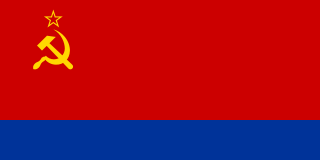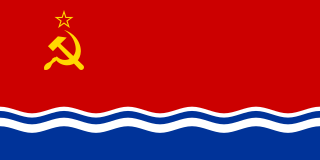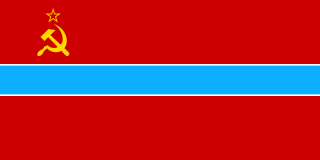
The State Flag of the Union of Soviet Socialist Republics, also simply known as the Soviet flag or the Red Banner, was a red flag with two communist symbols displayed in the canton: a gold hammer and sickle topped off by a red five-point star bordered in gold. The flag's design and symbolism are derived from several sources, but emerged during the Russian Revolution. It has also come to serve as the standard symbol representing communism as a whole, recognized as such in international circles, even after the dissolution of the Soviet Union in 1991.

The flag of Kazakhstan was adopted on 4 June 1992, replacing the Soviet-era flag. The flag was designed by Shaken Niyazbekov.

The national flag of Turkmenistan features a white crescent and five stars representing the five regions of the country and the Five Pillars of Islam. Placed upon a green field is a symbolic representation of the country's famous carpet industry. It was introduced as the flag of Turkmenistan on 27 September 1992 to replace the Soviet-era flag which consisted of a red background with two light blue bars in the middle. The modified version with a 2:3 ratio was adopted on 23 January 2001. State Flag and Constitution Day is celebrated on 18 May.

The flag of the Georgian Soviet Socialist Republic was adopted by the Georgian SSR on April 11, 1951.
The national flag of the Georgian Soviet Socialist Republic is of red cloth ratio of width to length is 1:2 In the upper corner near the staff box blue, the side of which is half the width of the flag in the middle of the square a circle whose radius is equal to one-third of the square in. range of hammer and sickle, above them a five-pointed star. From the circle to the square sides disagree 24 beam. the hammer and sickle, red star and red rays. From the middle of the right side of the square departs the band of blue across the flag length, width one-third of the square"

The flag of the Armenian Soviet Socialist Republic was adopted on 17 December 1952 by the government of the Armenian SSR. The flag is similar to the flag of the Soviet Union but has a ¼-width horizontal blue stripe in the middle. The red represents the "revolutionary struggle of the working masses" and the golden hammer and sickle represents the peasants' and workers' union.

The flag of the Azerbaijan Soviet Socialist Republic was a plain red flag with a golden hammer and sickle and a gold-bordered red star in its upper canton and an horizontal dark blue band on the bottom fourth, representing the Caspian Sea.

The Flag of the Byelorussian Soviet Socialist Republic was adopted on 25 December 1951. Prior to this, the flag was red with the Cyrillic characters БССР (BSSR) in gold in the top-left corner, surrounded by a gold border. Between 1937 and the adoption of the above flag in the 1940s, the flag was the same, but with a gold hammer and sickle above the Cyrillic characters and no border. Between 1919 and 1937, the flag was red, with the Cyrillic characters ССРБ (SSRB) in the top left-hand corner. In early 1919, a plain red flag was used. The final BSSR flag was used until the collapse of the Soviet Union in 1991. A flag based on this Soviet design is used as the national flag of Belarus.

The flag of the Kirghiz SSR was adopted by the Presidium of the Supreme Council of the Kirghiz SSR decreed by its Decree on 22 December 1952. The 1978 constitution of the Kirghiz SSR states that the ratio of the flag is 1:2 with the blue/white/blue stripes in the middle taking 1⁄3 of the flag height and the white stripes 1⁄20 of flag height.

The flag of the Latvian Soviet Socialist Republic shows a yellow hammer and sickle and outlined star on a red field above rippling water at the bottom, and was adopted by the (former) Latvian Soviet Socialist Republic on January 17, 1953.

The flag of the Lithuanian SSR was first adopted by the Lithuanian SSR in 1918, which was a plain red flag. After the Lithuanian SSR was established again in 1940, the flag was a red flag with the national name and a hammer and sickle in the upper canton. The flag in use from 1953 to 1988 was a red flag with the golden hammer and sickle and a gold-bordered red star in its upper canton with a white thin stripe and green thick band on the bottom.

The flag of the Moldavian Soviet Socialist Republic was adopted on 31 January 1952. The flag has three horizontal bands of red, green (1/4) and red, with a hammer and sickle in the canton. As defined by the Presidium of the Supreme Soviet of the Moldavian Soviet Socialist Republic on the flag description:
The national flag of the Moldavian Soviet Socialist Republic consists of a panel of red color with a green stripe in the middle of the whole flag length, with the image on top of the red part of the flag from the flagpole golden hammer and sickle above a five-pointed red star framed by gold border. The ratio of the flag's width to its length is 1:2 with the bandwidth of green to the width of the flag 1:4

The flag of the Tajik Soviet Socialist Republic was the red Soviet flag with white and green stripes below the gold hammer and sickle, with the measures: 1/2 red, 1/5 white, 1/10 green, 1/5 red. The flag sported the Pan-Iranian colors of red, white and green, as a nod to the republic's Persian-descended culture. The flag was adopted on March 20, 1953 by decree of the Supreme Soviet of the Tajik SSR:
The national flag of the Tajik Soviet Socialist Republic is a panel consisting of four horizontal colored stripes: the upper band of red which is half the width of the flag; white stripe, making one fifth of the width of the flag; green stripes, is one-tenth the width of the flag, and the lower band of red color, is one-fifth the width of the flag. On top of the red band at the flagpole located gold hammer and sickle and above them is a five-pointed red star framed by a gold border. The ratio of the flag's width to its length is 1: 2.The fitting of the hammer and sickle into a square whose side wound 1/4 width of the flag. The sharp end of the sickle falls in the middle of the upper side of the square, handles the sickle and hammer rest on the bottom corners of the square. hammer with a handle length is 3/4 of the diagonal of a square. The five-pointed star in a circle fits 1/8 width of the flag relating to the upper side of the square. Distance vertical axis of the star, the hammer and sickle from the grapnel is equal to 1/4 of the flag's width. The distance from the top edge of the flag of the flag to the center of the star - 1/10 of the flag's width.

The State Flag of the Turkmen Soviet Socialist Republic was adopted on 1 August 1953 and was replaced with the current flag of Turkmenistan in 1992. Although similar to the Flag of the Soviet Union, the layout is identical to the flag of the Kirghiz SSR with a ratio of 1:2. The two blue stripes between the red represents the rivers Amu Darya and Syr Darya, the red represents the "revolutionary struggle of the working masses", the hammer and sickle represents the peasants' and workers' union, and the red star is the symbol of the ruling Communist Party.

The first flag of the Ukrainian Soviet Socialist Republic (UkSSR) was adopted on 10 March 1919 to serve as the symbol of state of the Ukrainian SSR. Details of the official flag changed periodically before the collapse of the Soviet Union in 1991, but all had as their basis the communist red flag. According to the decree of the Presidium of Supreme Soviet of Ukrainian SSR on 21 November 1949, the blue in the bottom "symbolises the mightiness and beauty of the people, and the blue banner of Bohdan Khmelnytsky".

The flag of the Uzbek Soviet Socialist Republic was adopted on 29 August 1952. The red represents the "revolutionary struggle of the working masses", the hammer and sickle represents the peasants' and workers' union, and the red star is the symbol of the communist party. There is no official explanation for the symbolic meanings of other elements. However, in some material the white stripes represent cotton, the blue band represents Amu Darya and irrigation in general.

The flags of the Soviet Socialist Republics were all defaced versions of the flag of the Soviet Union, which featured a golden hammer and sickle and a gold-bordered red star on a red field.

The flag of the Republic of Karelia is the official state symbol of the Republic of Karelia. Adopted by the Supreme Council of the Republic of Karelia on February 16, 1993. The flag was designed by Alexander Ivanovich Kinnear.

The flag of the Karelo-Finnish Soviet Socialist Republic was adopted by the Karelo-Finnish SSR on 3 March 1953. The flag's design was based on the flag of the former Soviet Union, with the additional horizontal blue, and green bands added at the bottom. At the top of the flag near the flagpole were a golden hammer and sickle and the red star with a gold border. The green color symbolized the forest resources, and blue represented the abundance of rivers and lakes.

The coat of arms of the Kazakh Soviet Socialist Republic was adopted on 26 March 1937 by the government of the Kazakh Soviet Socialist Republic. The coat of arms is based on the coat of arms of the Soviet Union.

The flag of the Kabardino-Balkarian Autonomous Soviet Socialist Republic was adopted in 1957 by the government of the Kabardino-Balkarian Autonomous Soviet Socialist Republic. The flag is identical to the flag of the Russian Soviet Federative Socialist Republic.
























